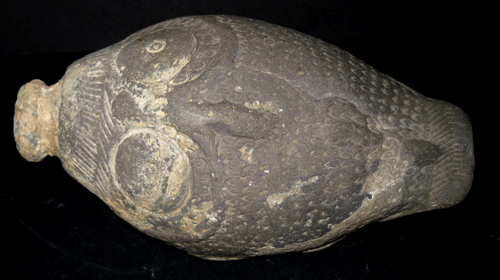Sphero-Conical Vessel with Stamped & Incised Decoration, 12th Century CE - 13th Century CE
Earthenware
6.5
SF.215
The sphero-conical vessel style of objects form a distinct group, homogeneously brought together by their shape and material. Usually, these objects are the same size. The form is characterized by...
The sphero-conical vessel style of objects form a distinct group, homogeneously brought together by their shape and material. Usually, these objects are the same size. The form is characterized by the “sphero-conical” shape of the body, the outline varies, but almost all have a narrow neck usually with a groove beneath the lip that would be used to tie a stopper down, and the opening is usually very small. The colour, texture and finish will vary. This sphero-conical vessel is made of dark earthenware, the surface is decorated with incised tear drops patterns. Most often, these objects are dark, fine grained and compact. Firing appears to be high as to render the object impenetrable. The thickness of the walls gives the object weight and strength, and no doubt helps to improve water tightness.
Objects such as this sphero-conical vessel have sparked debates in regards to their nature. Many of these objects appear to have been thrown and others have a mould-formed upper section. Rumoured uses of these objects include: hand grenades or incendiary bombs, a perfume flask, a fire-blower, a mercury bottle, a beer flask, a plumb bob, or a rose water sprinkler. One recently found at Samarra was believed to have an inscription stating that it was meant to contain a vintage wine.
It is clear however that these objects can serve a multitude of purposes and any of these proposals can be correct. However, one may ponder why such a very particular and laborious construction would be necessary to simply provide the required weight for a plumb bob? Whatever the case may be, Savage Smith (1997) explains: Sphero-conical vessels appear to be confined to the early and medieval Islamic periods-whatever their function, in later periods either different vessels were found appropriate, or the uses they served became extinct.
Objects such as this sphero-conical vessel have sparked debates in regards to their nature. Many of these objects appear to have been thrown and others have a mould-formed upper section. Rumoured uses of these objects include: hand grenades or incendiary bombs, a perfume flask, a fire-blower, a mercury bottle, a beer flask, a plumb bob, or a rose water sprinkler. One recently found at Samarra was believed to have an inscription stating that it was meant to contain a vintage wine.
It is clear however that these objects can serve a multitude of purposes and any of these proposals can be correct. However, one may ponder why such a very particular and laborious construction would be necessary to simply provide the required weight for a plumb bob? Whatever the case may be, Savage Smith (1997) explains: Sphero-conical vessels appear to be confined to the early and medieval Islamic periods-whatever their function, in later periods either different vessels were found appropriate, or the uses they served became extinct.
